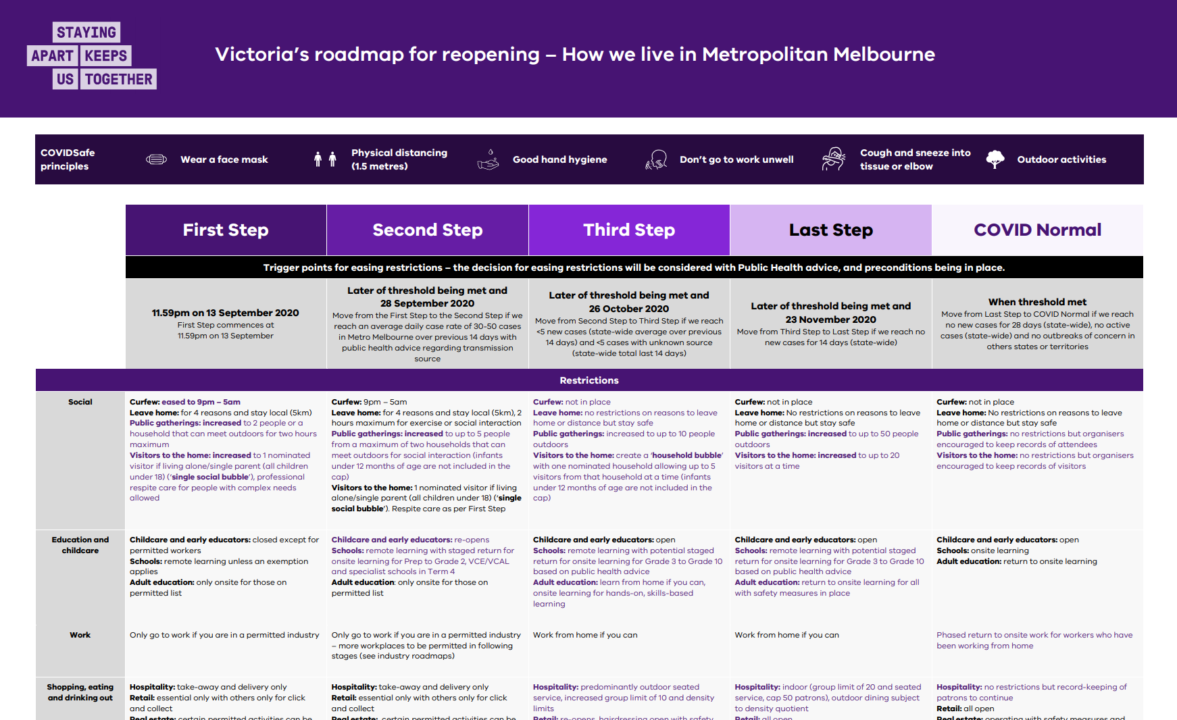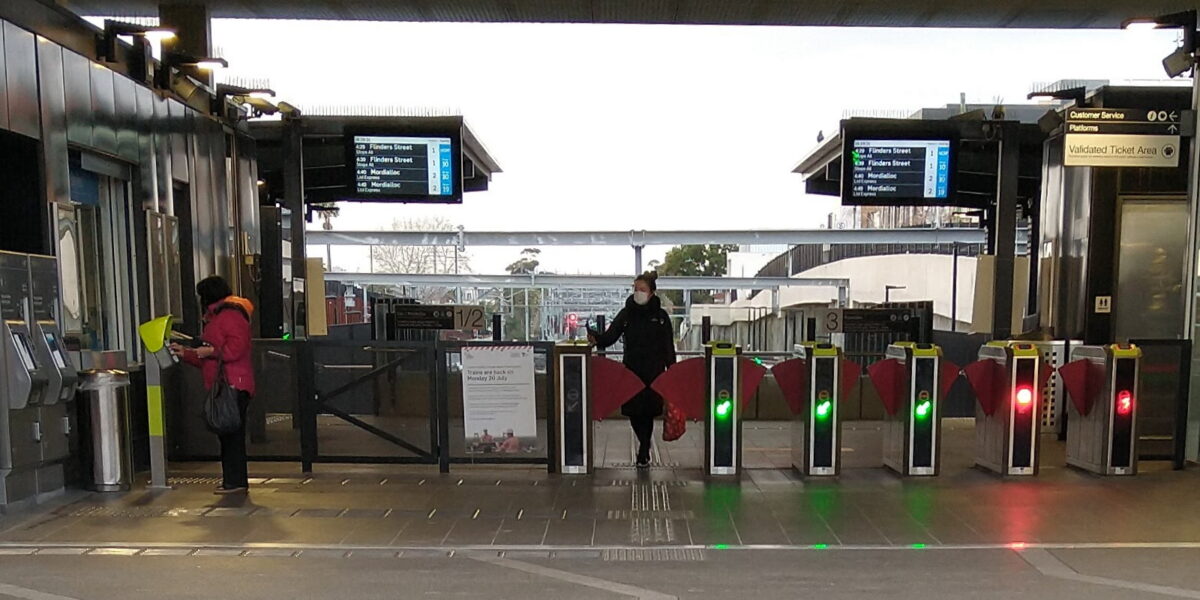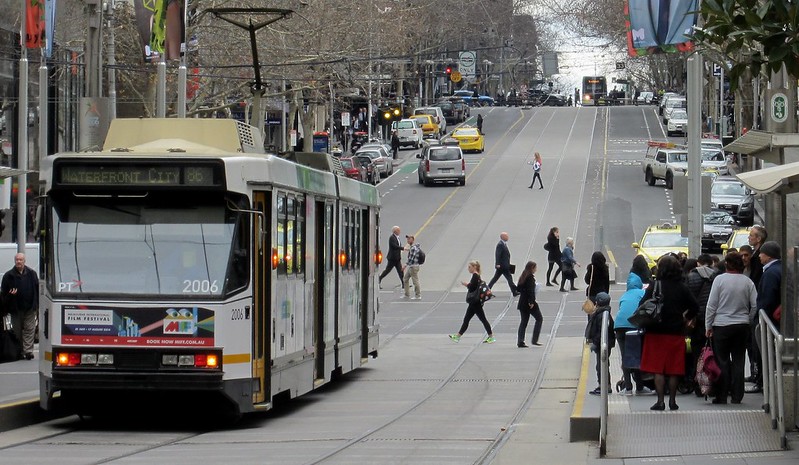The Victorian Government has released its roadmap out of COVID-19 restrictions. I’ve been pondering what this means for travel demand and public transport in Melbourne, and activity in the CBD, which largely drives PT patronage.
The steps in the roadmap (*which are mostly subject to case numbers) start from Sunday night.

1st Step (14th September)
The curfew start time pushes back from 8pm to 9pm. At the very least this should see authorities reinstate the train and tram services that were cut during that hour.
But really they should take the opportunity to restore all services (apart from after-midnight Night Network) – the long wait times continue to make life difficult for essential workers, and by encouraging normally loyal passengers to switch work trips to driving, may do permanent long term damage to evening patronage.
This step includes some expanded social interaction including social bubbles for those living alone (including beyond the 5km limit), but with no changes for workplaces or schools, it’s unlikely we’ll see a big increase in public transport patronage, or CBD activity.
2nd Step (28 September)*
The curfew remains in place, but there is some loosening of restrictions on social activities in public within 5km of home.
No changes in workplaces, including no changes in retail.
Some school students return, including VCE/VCAL, which will see some additional public transport patronage at school travel times, including beyond 5km from home.
3rd step (26 October)*
Night curfew removed. No restrictions on distance or reasons for leaving home, but still some limits on gatherings.
Most retail can re-open, though with some restrictions, and outdoor hospitality venues can open. This may trigger more trips for shopping, including via public transport to the CBD and the big retail centres – likely to be mostly outside peak hour, including evenings.
Some workplaces that require on-site staff can re-open, with COVID precautions in place. That also means commute travel demand will increase, including by public transport, but not so much for journeys to the CBD, given it is dominated by white-collar office workers who will continue to work from home.
The bigger patronage effect is likely to be on suburban routes, skewed towards buses that serve the retail centres and industrial employment areas. This was reflected in patronage in early August: just before Stage 4 workplace restrictions kicked-in, buses were at 17% of normal patronage, compared to Metro trains 11%, and V/Line and trams both at 9%.
This means that boosting bus frequencies in suburban areas should be a priority, to help ensure physical distancing as patronage comes back – including on weekend shopping centre services. Cutting wait times will also help with household budget recovery by ensuring that not everybody needs to drive to work.
Last (4th) Step (November 23)*
A further loosening, but still some restrictions in place on gathering numbers, including at home and in restaurants.
Even at this point, it’s still officially: Work from home if you can, meaning the CBD is likely to remain mostly empty of white-collar workers – so we won’t see big loads on CBD public transport.
(Not sure why it’s called the “Last step” when it’s not.)
“COVID Normal” (*when case thresholds are met)
At this point the plan is for a phased return to onsite work for those who have been working at home – which includes most CBD office workers.
Schools also return to all on-site learning.
Does this mean that travel demand and public transport will return to normal? I’m not sure.
It’s hard to imagine all office workers returning to onsite working while the risk of COVID-19 is still around. Employers are likely to be risk-averse (nobody wants their workforce knocked out by illness), and employees won’t be keen to sit at a desk for 8 hours wearing a mask.
They also won’t be keen to pack into trains, trams and buses. Which brings us to the next point.
Is public transport safe?
With many cities elsewhere in the world having re-opened, we can observe how things have been going. There are strong indications that if one assumes:
- mandated use of masks and face coverings,
- increased cleaning,
- good hand hygiene, and
- physical distancing
…then using public transport is not a significant transmission risk.
Indeed if you look around, you’ll find very few documented cases of transmission via public transport under those conditions. There are some suspected cases (including recently in New Zealand), but these did not involve masks.
In Victoria we’ll clearly be wearing masks for a while yet.
Mr Andrews said the use of masks was a high-reward, low-cost extra level of protection that will be needed when people start to mingle.
ABC News: Victorian Premier Daniel Andrews unveils roadmap to easing coronavirus restrictions
Additionally, recent research seems to indicate that the early fears of the virus spreading via shared touch surfaces may have been overblown. Still, the additional cleaning, messaging around hand hygiene, and distribution of hand sanitiser dispensers at busy stops probably reduces the risk.
Some cities are trialling special cleaning methods that provide additional longer-term protection, which is also worth looking at to help keep passengers safe.
If masks, cleaning and hand hygiene are mostly okay, the big issue on public transport is physical distancing.
How to reduce crowding?
The PT elephant in the room is: How can you maintain physical distancing when public transport is crowded?
The answer is: you can’t. So the challenge for Government is to curb the crowding – to slow down patronage recovery until a vaccine is found.
This is closely related to how workplaces will function, and how many people will travel to work at peak times.
There are options for Government, which include:
- Boost off-peak, evening and weekend services to encourage travel outside peak by cutting waiting times and crowding
- Introduce off-peak discounts – already applied to V/Line, so the Myki system should be capable of this
- Removing the Free Tram Zone, which causes overcrowding on CBD trams
These will need to be combined with continued Work From Home arrangements for white-collar employees. This might mean staggered start times, only coming into the office on certain days each week (or certain weeks), or only coming in for important meetings or workshops.
A mix of these measures can do a lot to help keep peak hour demand down and help people who have to travel to maintain physical distancing.
What about the long term effects on travel demand, public transport patronage, and CBD growth, once COVID is finally defeated by a vaccine hopefully within a year or two? That’ll be the subject of another post.






11 replies on “What does the COVID roadmap mean for PT?”
The “phased return to onsite work” is so silly. Nobody who can work from home should be returning to work, when there is no vaccine.
Working from home is the simplest thing we can do to help stop the virus spreading, and it costs us absolutely nothing to do. The government should maintain its “work from home if you can” policy until there’s a vaccine and sufficient numbers of people have had it.
I’ve heard some large employers in the CBD are finding employees happier and more productive from home. I suppose we don’t know if that will continue to be the case into the future, or is partly due to covid fear, but the cost of an office in the city are not insubstantial, so it’s possible not all will return ever.
This could mean depending how you see it, that Melbourne Metro is either a white elephant or spare capacity that has never existed before.
But as there is likely to be another pandemic sooner rather than later (bearing in mind encroachment into wilderness areas and industrial meat production) it might be a useful insurance policy.
Melbourne could try a system like Sydney is using, with green plastic dots stuck to seats and on the floor of public transport to mark out when you can stand or sit. Once there are not green dots you’re encouraged to leave the the vehicle and wait for another service. There are also marshals around that prevent passengers boarding trains and buses that are over maximum capacity and the slogan “no dot, no spot”. The capacity they want to promote is roughly 50% of seats only filled. The message from our premier is to avoid public transport unless you have no other means of travel. Peak hour fares were also extended in time to discourage people from travelling except for in the middle of the day or late in the evening.
Great article Daniel, I think public transport patronage will take sometime to return to somewhat normal levels and given office workers won’t likely return to their city offices for a prolonged period I think a new temporary timetable is required.
Trains could run every 10 to 15 minutes on all lines in the day and every 20 to 30 minutes in the evenings giving people more off peak services to reduce crowding. This will need to be coupled with more staggered work hours and part working in the office and part working at home to limit commuter numbers. I think you are right more cross town bus services are needed to support travel to shopping and activity centres.
In Perth public transport patronage has already returned to 75% of pre-COVID levels. Since most of the demand is from CBD office workers, these offices are likely to be close to their pre-COVID occupancy. The same could potentially occur in Melbourne, except…
– companies with offices in the Melbourne CBD are likely to be under greater financial pressure than in Perth’s mining-based economy, and will look to down-size their office footprint when leases come up for renewal by encouraging more of their employees to conduct most of their work from home
– more positions will be advertised that can be conducted anywhere, including home working (the Vic government was already heading that way pre-COVID)
– the longer commute in Melbourne than Perth will lead to more workers in middle and outer suburbs choosing to work from home for more days
You are very much correct on the lack of research into whether PT exacerbates the spread of the virus and with so much cleaning and the wearing of masks, the risks have to be so much lower than they were in say March. The green dot initiative mentioned in another comment sounds useful and atleast guides people to where they should stand rather than having them guess and create friction on board the vehicle.
Working from home is an interesting topic which has had so much attention placed on it. With my previous employer, all of the sales team ex 2 people from HO worked from home. It was just how it was done and because HO was in Adelaide, there really was no office. I really enjoyed it, I could work and sort things out things at home with so much more flexibility (mainly kids). In my current occupation, HO is in Fairfield. I still enjoy working from home but the interaction with team members is really lacking. It’s not only the social aspect, its also just being around the team and discussing projects and seeing our factory and what is going on in there. I don’t think I would go back to 5 days a week in the office but 2 or 3 days would be fine.
Working from home has many benefits including productivity, however I think in 12mths time people will be getting tired of it. They will be looking for opportunities to interact with others, see real faces. Whilst I always found working from home productive, I was also super keen to be out visiting clients or be on the phone talking to my colleagues who were also in the same position. I craved that interaction. If your role doesn’t have much of this and you are at home all of the time, the gloss will be well worn in 12mths time. Some won’t mind, but others certainly will.
Is the current toughness really such a vital and good thing?
I am all supportive of many restrictions such as masks, and will continu to wear both a mask and a face shield too. I will always carry hand sanitizer and will use it when I wish to.
I do agree those, are with some other things of which should stay long term.
We do now understand that, Andrews, has slapped many over-the-top restrictions, of which have no medical advice whatsoever.
90% of all cases in Vic, are, all within known care home hotspots.
Having said what I have in my previous post here, it would be interesting as to what springs back once the lockdown is in fact lifted.
I hear, that people with young kids, cant wait to get back to work. While workers with older kids, prefer it at home.
Others who will be keen to return to the office are,
++ those seeking the social interaction
++ those with small homes, nowhere to put a small office.
++ those who have too many distractions at home
++ those who just hate being stuck at home for too long.
There is sure to be a downturn in people wanting to travel daily to work. This is sure to impact the amount of people using public transport.
We may end up having, people who work some days at home, and some days in the office. Perhaps do their computer work at home, but, still meet in person once a week for a weekly meeting.
Then, how will things change over time?
We are sure to have a population growth, that will fill the void left by the pandemic impact, and, how many of those who prefer it at home today, find out there is some fun or other reason for catching the train in to work each day.
Danial, you say the elephant in the room is the PTV, I say it is the government, the government need to provide the funds for increased service levels, removing single train tracks (duel tracks to terminus, order the last 50 E-Class trams in the 2015 blueprint, fast track the new generation trams and ensure the trams are being delivered at approximately 2.5 per month. on another point the government wants small projects to build our way out of recession, the best can suggest is a concerted effort to rebuild the for the 2032 deadline for accessible transport for everyone.
@Robert, ??? – I didn’t mention PTV.
[…] This is a follow-up on my post about the roadmap out of COVID. […]